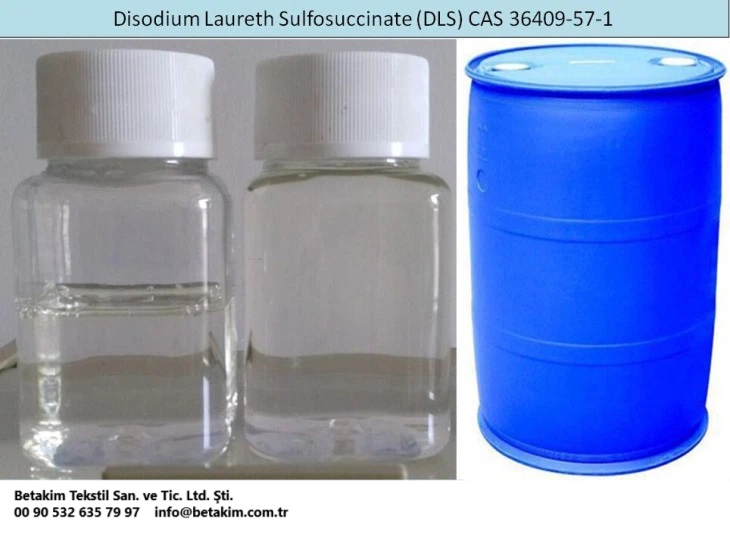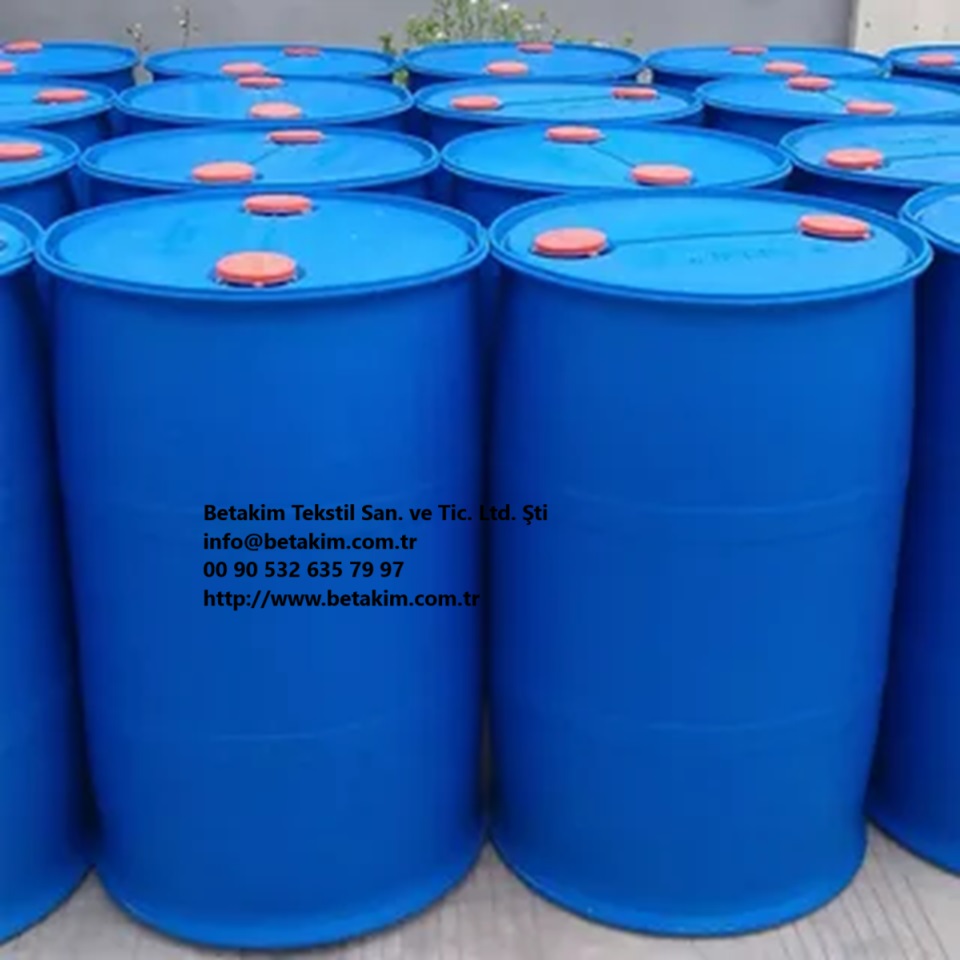İş inovasyonunu en üst düzeye çıkararak iş potansiyelinizi ortaya çıkarıyoruz.
Eposta GönderDİSODİUM LAURETH SÜLFO SUKSİNAT, Disodyum Laureth Sulfosüksinat (DLS), Dodesil Sodyum Sülfo Süksinat, Dodecyl Sodium Sulfosuccinate, DLS, LDSS, 13192-12-6
BASF ÜRÜNLERİ:
Disponil® SUS 87 Spez. EVO Mono-alkyl sulfosuccinate, sodium salt (5 EO) Liquid approx. 30 approx. 30
Ürün Açıklaması:
-
Ürün Adı: Disodyum Laureth Sulfosüksinat (DLS)
-
Kimyasal Formül: C₁₆H₂₈Na₂O₇S
-
CAS Numarası: 13192-12-6
-
Görünüm: Renksiz veya hafif sarı sıvı
-
Moleküler Ağırlık: 410.43 g/mol
-
Yoğunluk: Belirtilmemiş
-
Çözünürlük: Suda çözünür
Fiziksel ve Kimyasal Özellikler:
-
Fiziksel Özellikler:
-
Görünüm: Renksiz veya hafif sarı sıvı
-
Çözünürlük: Suda çözünür
-
-
Kimyasal Özellikler:
-
Kimyasal Formül: C₁₆H₂₈Na₂O₇S
-
Reaktivite: Genellikle kimyasal olarak inerttir ve birçok kimyasal madde ile reaksiyona girmez. Ancak, yüksek sıcaklıklarda veya güçlü oksitleyici maddelerle reaksiyona girebilir.
-
pH Stabilitesi: Geniş bir pH aralığında kararlıdır
-
Kullanım Alanları:
-
Kişisel Bakım Ürünleri: Şampuanlar, köpük banyosu, sabunlar ve vücut yıkama ürünlerinde yüzey aktif madde, köpük artırıcı ve cilt bakım ajanı olarak kullanılır.
-
Temizlik Ürünleri: Çamaşır deterjanları, bulaşık deterjanları ve zemin temizleyicilerde kullanılır.
-
Endüstriyel: Çeşitli endüstriyel uygulamalarda, deterjanlar ve temizleyicilerde kullanılır.
-
Tarım: Pest kontrol gibi çeşitli tarımsal uygulamalarda anyonik yüzey aktif madde, çözücü, emülgatör ve ıslatıcı madde olarak kullanılır.
Diğer İsimler:
-
Disodyum 4-dodecyl 2-sulphonatosuccinate
-
Dodecyl sodium sulfosuccinate
-
LDSS
Yaygın Adı:
-
Disodyum Laureth Sulfosüksinat (DLS)
CAS No.: 13192-12-6
EC No.: 236-149-5
Disodyum laureth sülfosüksinat, birçok şampuan ve diğer temizlik ürünlerinde kullanılan bir yağ çözücü, emülgatör ve köpürtücü madde olarak işlev görür. Saç ve cilt için nazik bir temizleme maddesi olarak kabul edilir.
Kullanım:
Deterjan: diş macunu, şampuan, kozmetik, deterjan, vb. -
İnşaat: alçıpan, beton katkı maddesi, kaplama, vb. -
Eczacılık: İlaç, pestisit, vb. -Deri: deri yumuşak maddesi, yün temizleme maddesi, vb. -
Kağıt yapımı: penetran, flokülasyon maddesi, mürekkep giderme maddesi, vb. -
Yardımcı maddeler: tekstil yardımcı maddeleri, plastik yardımcı maddeleri, vb. -
Yangınla mücadele: petrol kuyusu yangınıyla mücadele, yangınla mücadele cihazı, vb. -
Mineral seçimi: maden flotasyonu, kömür su karışımı, vb.
Uygulamalar
Temizlik ve hijyen Disodyum laureth sülfosüksinat, birçok temizlik uygulaması olan çamaşır deterjanlarında esas olarak kullanılır. Son derece etkili bir yüzey aktif maddedir ve yağlı lekelerin ve kalıntıların çıkarılmasını gerektiren her türlü görevde kullanılır; örneğin, Disodium laureth sülfosüksinat, motor yağ çözücüler, zemin temizleyiciler ve araba yıkama sabunları gibi endüstriyel ürünlerde daha yüksek konsantrasyonlarda bulunur. Daha düşük konsantrasyonlarda, diş macunlarında, şampuanlarda, tıraş kremlerinde ve köpük banyosu formüllerinde, köpük (köpük) oluşturma yeteneği, yüzey aktif madde özellikleri ve kısmen koyulaştırıcı etkisi nedeniyle bulunur.
Gıda katkı maddesi Disodium laureth sülfosüksinat, eşanlamlısı Disodium laureth sülfosüksinat olarak görünür ve 21 CFR 172.822'de yayınlanan yönergelere göre gıda kullanımı için genel olarak güvenli (GRAS) bir bileşen olarak kabul edilir. Bir emülsifiye edici madde ve çırpma yardımcısı olarak kullanılır. Disodium laureth sülfosüksinatın geçici olarak tatlılık algısını azalttığı bildirilmiştir. Laboratuvar uygulamaları
Başlıca uygulamalar
Disodyum lauret sülfosüksinat, bilimde sodyum dodeasil sülfat olarak adlandırılır, temizleme prosedürlerinde kullanılır ve genellikle RNA ekstraksiyonu ve/veya DNA ekstraksiyonu sırasında hücreleri lize etmek ve Disodyum lauret sülfosüksinat
-PAGE tekniğinde elektroforez hazırlığında proteinleri denatüre etmek için bir bileşen olarak kullanılır.
Disodyum lauret sülfosüksinat
-PAGE uygulaması durumunda, bileşik proteinlerdeki kovalent olmayan bağları bozarak ve böylece onları denatüre ederek, yani protein moleküllerinin doğal konformasyonlarını ve şekillerini kaybetmelerine neden olarak çalışır.
Yüksek afinite ve yüksek konsantrasyonlarda proteinlere bağlanarak, negatif yüklü deterjan tüm proteinlere benzer bir net negatif yük ve dolayısıyla benzer bir yük-kütle oranı sağlar.
Bu şekilde, jeldeki polipeptit zincirlerinin hareketliliğindeki fark, hem boyutlarına hem de yüklerine değil, yalnızca boyutlarına atfedilebilir.
Protein moleküllerinin analizini basitleştirmek için polipeptit zincirinin boyutuna dayalı ayırma yapmak mümkündür, bu, proteinleri deterjan Disodyum lauret sülfosüksinat ile denatüre ederek elde edilebilir. Disodyum lauret sülfosüksinat moleküllerinin protein molekülleriyle ilişkisi, oluşan moleküler kümeye ilişkili bir negatif yük verir; bu negatif yük, o proteinin orijinal yükünden önemli ölçüde daha büyüktür.
Disodyum lauret sülfosüksinat bağlanmasıyla oluşan elektrostatik itme, proteinleri çubuk benzeri bir şekle zorlar, böylece jellerde elektroforetik ayırma için bir faktör olan şekil farklılıklarını ortadan kaldırır.
Dodeasil sülfat molekülü, elektroforez için kullanılan pH değerinde iki negatif yüke sahiptir, bu, kaplanmış polipeptit zincirlerinin net yükünün kaplanmamış zincirlerden çok daha negatif olmasına yol açacaktır. Yük-kütle oranı, farklı proteinler için esasen aynıdır çünkü Disodyum lauret sülfosüksinat kaplaması yüke hakimdir.

